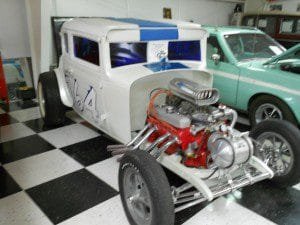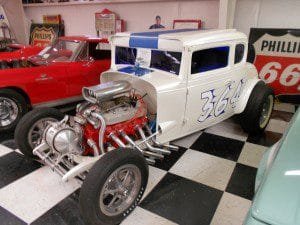Nothing like a restored vintage automobile and this restored 1931 Chevy Coupe hot rod is a great example. Restoring an old vintage car is not an inexpensive job. By the time you find parts and the paint you desire, the costs can be significant. At the same time, if you do a good job you can end up with a beauty. Some auto enthusiasts restore cars to add value and then resell the auto. Others restore and customize and keep it in their car collection. Either way it can be fun and rewarding.

The hot rod Chevy 1931 Coupe in this picture is on display at the Santa Rosa New Mexico Auto Museum located on old Route 66. A fine location for an automobile General Motors advertised the Chevy Coupe as the perfect car for women since the car seats five and it got excellent gas mileage.
Advertising also points out that the 4-wheel brakes are weather-proof and trouble-proof. The 1931 Chevy Coupe came with a six cylinder engine as standard equipment. This was the third year that Chevrolet was offering the six cylinder engine and they picked up momentum against Ford. This came to a stop however in 1932 when Ford came out with their flat-head eight cylinder offering. In fact, the popular story is that Chevy had some knowledge that Ford was going to introduce their eight cylinder engine with some of their 1932 models and consequently Chevrolet came across with smoother lines with their 1932 models in an effort to offset gains by Ford. In 1931, Chevrolet offered three new styles. The Cabriolet, the Landau Phaeton and the Five Passenger Coupe.
The Coupe was the lowest priced model at about $595 by most sources. The early 1930’s were certainly a challenging time for all automakers as the nation entered the Great Depression. Price competition was enormous and any edge Chevy could get over Ford and vise versa was important.
The restored car shown on this page has a Buick 401 Nailhead Engine. This was Buick’s large car and later muscle car eight cylinder engine. General Motors first eight cylinder engine after World War Two was the Oldsmobile Rocket V8. The first Nailhead was introduced for the 1953 model year as a replacement for the straight-eight engine. The first engine displaced 321 CI. The 8 cylinder Nailhead was first used in larger models and then later in midsized cars. The new Nailhead engine became popular with hot rodders in the mid 1950’s. In 1957 Buick came out with a 365 CI displacement engine . A 325 HP 401 CI Nailhead came out in 1959 in the higher end Invicta and Electra models. In 1963 even a larger Nailhead was introduced with 340 HP and 425 CI.
Chevy’s 1932 models were thought to have a more expensive look to them. The frills and windows had new designs and the car itself sat lower to the ground with their new 18 inch wheels. A lot of the 1932 model year styling had the influence of Cadillac and Oldsmobile. There were engine changes from 1931 to 1932 with the use of a downdraft carburetor as opposed to the 1931’s updraft. Also, improved compression ratios and rubber mounts to the frame.

The Chevrolet name and brand has an interesting story. The Chevrolet brand was formed by William Durant and Louis Chevrolet. Durant was an ex-board member of GM. In 1915, Durant sold his shares in the company to Chevrolet.
The name Chevrolet was known in early auto racing. Louis Chevrolet was an engineer and Swiss race car driver. Prior to organizing the Chevrolet Motor Car Company., Chevrolet worked for Fiat as a race driver and later drove race cars for Buick. In addition to driving race cars, Chevrolet also helped to design them. One of Chevrolet’s designs was the Cornelian which came in at 20th place in the 1915 Indianapolis 500. In 1916, Chevrolet and two partners began the Frontenac Motor Corporation designing, building and racing their new line of race cars. Louis Chevrolet drove a total of four times in the Indianapolis 500.
(Article and photos copyright Auto Museum Online)